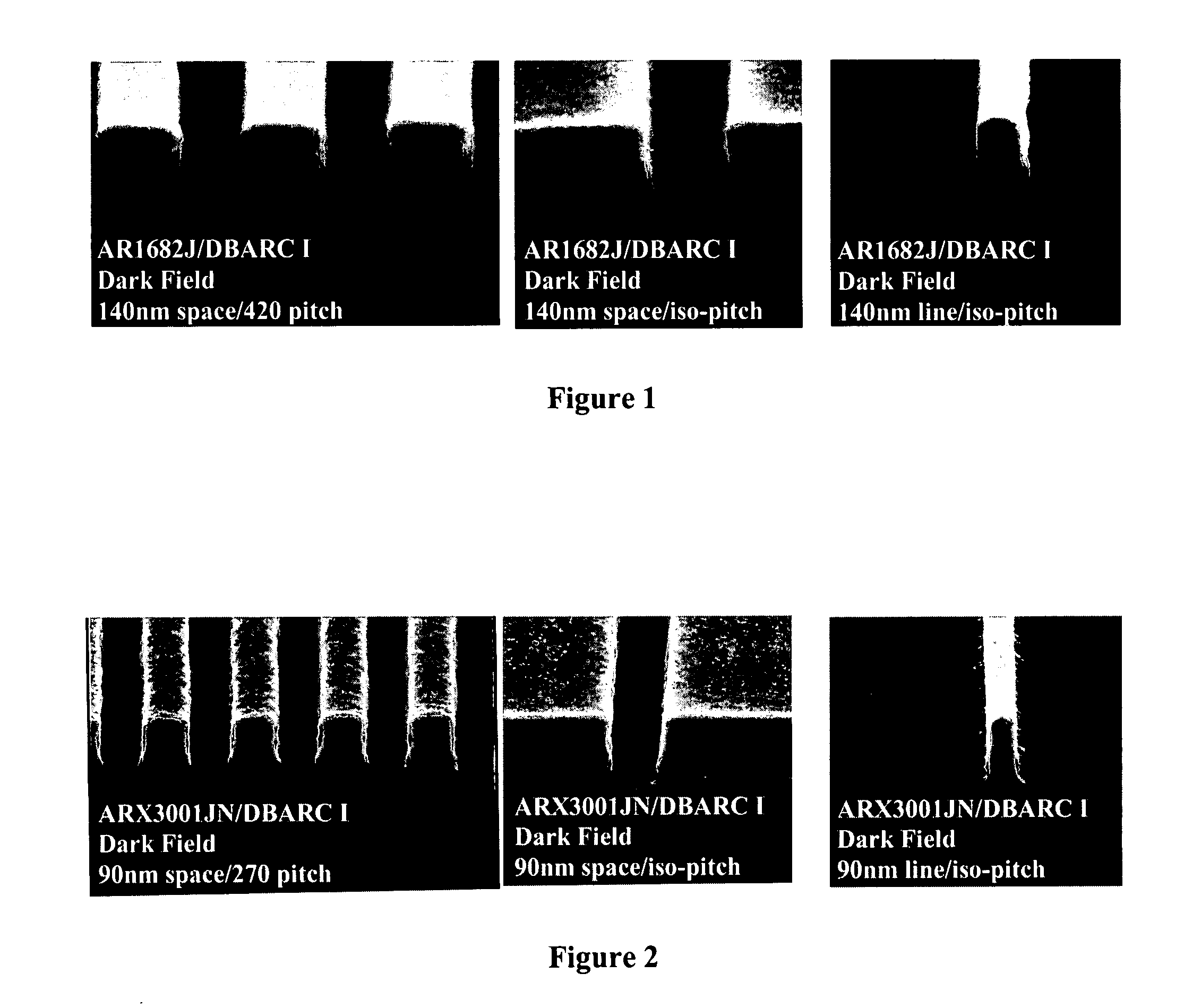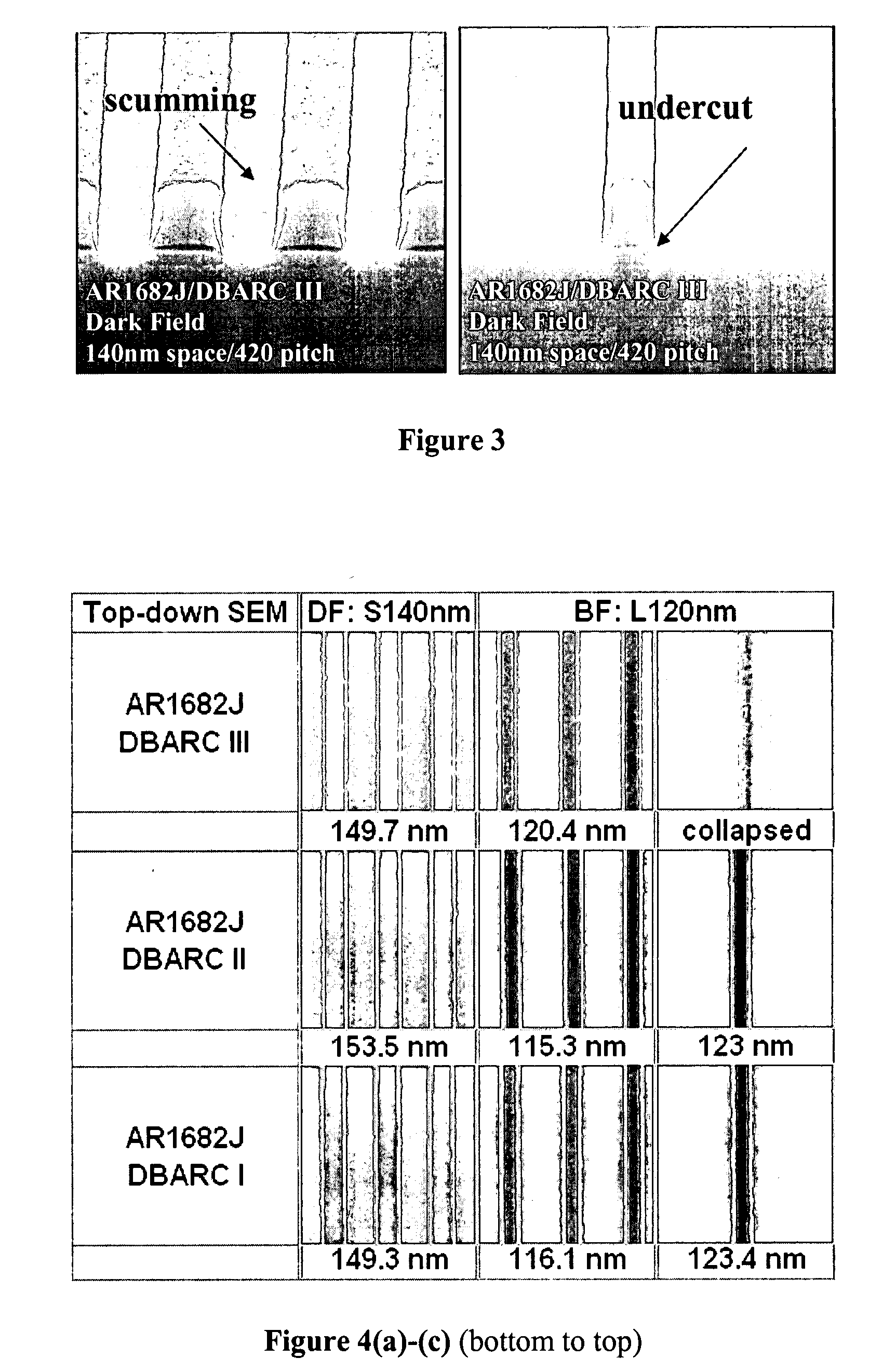Radiation-Sensitive, Wet Developable Bottom Antireflective Coating Compositions and Their Applications in Semiconductor Manufacturing
a technology of anti-reflective coatings and compositions, applied in the direction of photosensitive materials, instruments, photomechanical treatment, etc., can solve the problems of line width variation, thin film interference (or standing waves), and reflective notching, so as to reduce or eliminate scumming and minimize or prevent undercutting
- Summary
- Abstract
- Description
- Claims
- Application Information
AI Technical Summary
Benefits of technology
Problems solved by technology
Method used
Image
Examples
example 1
Calculation of Molar Volume of Photoacids
[0236]The molar volume of various photoacids was calculated using the ACD ChemSketch 10.0 program available from Advance Chemistry Development, Inc. Chemical structures were drawn and the size of the photoacids was calculated in terms of molar volume. The molar volume of representative photogenerated acids, reported in units of cm3, is shown in Table 1.
TABLE 1Molar volume of photoacidsPhotoacidMolar Volume (±3 cm3)(CF3SO2)3CH207.2(CF3SO2)2NH145.2(CF3CF2SO2)2NH200.1[CF3(CF2)3SO2]2NH309.9
example 2
Photolithography Using Novel DBARC Composition I and Resist I
[0237]To 10 ml of DBARC solution BSI.W06055B 07193.001JL (available from Brewer Science Inc., Rolla, Mo.) containing 0.1175 g of polymer and 0.0425 g of crosslinker and dye were added 2.065 mg of triphenylsulfonium tris(trifluoromethanesulfonyl)methide and 0.245 mg of 1-piperidine ethanol as quencher. The resulting DBARC solution was filtered through a 0.5 micron filter. A silicon wafer was coated with 550 Å of the DBARC solution prepared above and hard-baked at 160° C. for 60 seconds. Next, the DBARC-coated wafer was coated with 1950 Å of JSR ARX1682J photoresist (available from JSR Micro, San Jose, Calif.) and soft-baked at 110° C. for 60 seconds. The coated wafer was then exposed to 193 nm UV radiation through a binary chrome-on-glass mask using Nikon S305B scanner. After exposure the wafer was baked at 110° C. for 60 sec. and wet developed for 40 sec. using PD523 trimethylammonium hydroxide developer (available from Mo...
example 3
Photolithography Using Novel DBARC Composition I and Resist II
[0239]To 10 ml of DBARC solution BSI.W06055B 07193.001JL (available from Brewer Science) containing 0.1175 g of polymer and 0.0425 g of crosslinker and dye were added 2.065 mg of triphenylsulfonium tris(trifluoromethanesulfonyl)methide and 0.245 mg of 1-piperidine ethanol as quencher. The resulting DBARC solution was filtered through a 0.5 micron filter. A silicon wafer was coated with 550 Å of the DBARC solution prepared above and hard-baked at 160° C. for 60 sec. Next the DBARC-coated wafer was coated with 1950 Å of JSR ARX3001JN photoresist (available from JSR Micro) and soft-baked at 110° C. for 60 sec. The coated wafer was then exposed to 193 nm UV radiation through a binary chrome-on-glass mask using Nikon S3057E scanner. After exposure the wafer was then baked at 110° C. for 60 sec. and wet developed for 40 sec. using PD523 developer from Mosses Lake Industries. Finally the patterns formed on the wafer were analyze...
PUM
| Property | Measurement | Unit |
|---|---|---|
| temperature | aaaaa | aaaaa |
| molar volume | aaaaa | aaaaa |
| molar volume | aaaaa | aaaaa |
Abstract
Description
Claims
Application Information
 Login to View More
Login to View More - R&D
- Intellectual Property
- Life Sciences
- Materials
- Tech Scout
- Unparalleled Data Quality
- Higher Quality Content
- 60% Fewer Hallucinations
Browse by: Latest US Patents, China's latest patents, Technical Efficacy Thesaurus, Application Domain, Technology Topic, Popular Technical Reports.
© 2025 PatSnap. All rights reserved.Legal|Privacy policy|Modern Slavery Act Transparency Statement|Sitemap|About US| Contact US: help@patsnap.com



